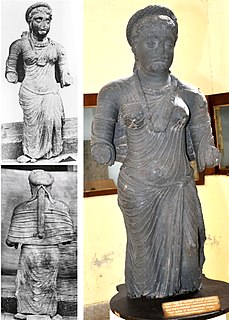Related Research Articles

NinḫursaĝDNIN-ḪUR.SAG Sometimes transcribed Ninkharsag. also known as Damgalnuna or Ninmah, was the ancient Sumerian mother goddess of the mountains, and one of the seven great deities of Sumer. She is principally a fertility goddess. Temple hymn sources identify her as the "true and great lady of heaven" and kings of Sumer were "nourished by Ninhursag's milk". Sometimes her hair is depicted in an omega shape and at times she wears a horned head-dress and tiered skirt, often with bow cases at her shoulders. Frequently she carries a mace or baton surmounted by an omega motif or a derivation, sometimes accompanied by a lion cub on a leash. She is the tutelary deity to several Sumerian leaders.

Neith was an early ancient Egyptian deity. She was said to be the first and the prime creator, who created the universe and all it contains, and that she governs how it functions. She was the goddess of the cosmos, fate, wisdom, water, rivers, mothers, childbirth, hunting, weaving, and war.

A mother goddess is a goddess who represents or is a personification of nature, motherhood, fertility, creation, a protective figure against destruction, or who embodies the bounty of the Earth. When equated with the Earth or the natural world, such goddesses are sometimes referred to as the Mother Earth or Earth Mother, who is paired along with the Sky Father deity in various animistic or pantheistic religions. In some religious traditions or movements, Heavenly Mother is the wife or feminine counterpart of the Sky father or God the Father.

In Ancient Egyptian religion, Taweret is the protective ancient Egyptian goddess of childbirth and fertility. The name "Taweret" (Tȝ-wrt) means "she who is great" or simply "great one", a common pacificatory address to dangerous deities. The deity is typically depicted as a bipedal female hippopotamus with feline attributes, pendulous female human breasts, the limbs and paws of a lion, and the back and tail of a Nile crocodile. She commonly bears the epithets "Lady of Heaven", "Mistress of the Horizon", "She Who Removes Water", "Mistress of Pure Water", and "Lady of the Birth House".

The Royal Asiatic Society of Great Britain and Ireland, commonly known as the Royal Asiatic Society (RAS), was established, according to its royal charter of 11 August 1824, to further "the investigation of subjects connected with and for the encouragement of science, literature and the arts in relation to Asia." From its incorporation the society has been a forum, through lectures, its journal, and other publications, for scholarship relating to Asian culture and society of the highest level. It is the United Kingdom's senior learned society in the field of Asian studies. Fellows of the society are elected regularly. Fellows include highly accomplished and notable scholars of Asian studies. They are entitled to use the post-nominal letters FRAS.
Kumzari is a Southwestern Iranian language that is similar to the Persian, Achomi and Luri languages. Although vulnerable, it survives today with between 4,000 and 5,000 speakers. It is spoken by Kumzaris in the Kumzar coast of Musandam Peninsula, northern Oman. This is the only Iranian language spoken exclusively in the Arabian Peninsula. Kumzaris can also be found in the towns of Dibba and Khasab as well as various villages, and on Larak Island. The speakers are descendants of fishermen who inhabited the coast of the Persian Gulf and the Gulf of Oman.

TheAsiatic Society of Mumbai is a learned society in the field of Asian studies based in Mumbai, India. It can trace its origin to the Literary Society of Bombay which first met in Mumbai on 26 November 1804, and was founded by Sir James Mackintosh. It was formed with the intention of "promoting useful knowledge, particularly such as is now immediately connected with India". After the Royal Asiatic Society of Great Britain and Ireland was established in London in 1823, the Literary Society of Bombay became affiliated with it and was known as the Bombay Branch of the Royal Asiatic Society (BBRAS) since 1830. The Bombay Geographical Society merged with it in 1873, followed by the Anthropological Society of Bombay in 1896. In 1954, it was separated from the Royal Asiatic Society and renamed the Asiatic Society of Bombay. In 2002, it acquired its present name. It is funded by an annual grant from the Central Government of India.

Rajuvula was an Indo-Scythian Great Satrap (Mahākṣatrapa), one of the "Northern Satraps" who ruled in the area of Mathura in the northern Indian Subcontinent in the years around 10 CE. The Mathura lion capital was consecrated under the reign of Rajuvula. In central India, the Indo-Scythians had conquered the area of Mathura from Indian kings around 60 BCE. Some of their satraps were Hagamasha and Hagana, who were in turn followed by Rajuvula.

Qumis, also known as Hecatompylos was an ancient city which was the capital of the Arsacid dynasty by 200 BCE. The Greek name Hekatompylos means "one hundred gates" and the Persian term has the same meaning. The title was commonly used for cities which had more than the traditional four gates. It may be understood better as the "Many Gated". Most scholars locate it at Sahr -e Qumis, in the Qumis region in west Khurasan, Iran.

Shukra is a Sanskrit word that means "clear" or "bright". It also has other meanings, such as the name of an ancient lineage of sages who counselled Asuras in Vedic history. In medieval mythology and Hindu astrology, the term refers to the planet Venus, one of the Navagrahas.
Shivi is mentioned as a kingdom and as the name of a king in the ancient Indian epic Mahabharata. There was a king named Shivi who became famous as Shivi or the kingdom itself may be named after him. Shivi king was famous for his truthfulness. The legend about his truthfulness and compassion goes as follows: King Shivi protected a dove who was chased by a hawk, and gave flesh from his thigh, as a substitute meal to the hawk.

Lovamahapaya is a building situated between Ruwanweliseya and Sri Mahabodiya in the ancient city of Anuradhapura, Sri Lanka. It is also known as the Brazen Palace or Lohaprasadaya because the roof was covered with bronze tiles.
Village deities are a common feature of the Hindu pantheon of deities. They are known as Gramadevatas. Each Hindu region and caste of India and South Asia has its share of village deities. Sri Lankan Tamils venerate their own group of village deities throughout Sri Lanka, specifically in the Tamil-dominated north and east of the island nation.

Jimsar County is a county in Changji Hui Autonomous Prefecture, Xinjiang, China. It contains an area of 8,149 km2 (3,146 sq mi). According to the 2002 census, it has a population of 130,000.

The Tākri script is an abugida writing system of the Brahmic family of scripts. It is derived from the Sharada script formerly employed for Kashmiri. It is the sister script of Laṇḍā scripts. It is the parent script of Dogra Akkhar employed in Jammu region. Chambeali Takri was considered by Grierson as the standard form of Takri, primarily because it was the first variety that was developed for print. In addition to Chamba and Dogra, there are numerous varieties, “with each Hill State or tract having its own style.” Until the late 1940s, the adapted version of the script was the official script for writing Dogri in the princely state of Jammu and Kashmir and for Kangri, Chambyali and Mandyali in Himachal Pradesh. However, the Takri script used in the Sirmour in Himachal Pradesh and Jaunsar-Bhawar region in Garhwal hills has some distinction.

Ferghana horse were one of China's earliest major imports, originating in an area in Central Asia. These horses, as depicted in Tang dynasty tomb figures in earthenware, "resemble the animals on the golden medal of Eucratides, King of Bactria ."

The Śāradā, Sarada or Sharada script is an abugida writing system of the Brahmic family of scripts. The script was widespread between the 8th and 12th centuries in the northwestern parts of Indian Subcontinent, for writing Sanskrit and Kashmiri. Originally more widespread, its use became later restricted to Kashmir, and it is now rarely used except by the Kashmiri Pandit community for religious purposes.

Meitei mythology, also known as Kanglei mythology or Manipuri mythology, are the body of narrative myths, originally told by the Meitei people and a genre of Ancient Meetei folklore. Kanglei mythology forms one of the main characteristics of the art and culture of Manipur including Meitei literature.

The Weber Manuscript, also called Weber Manuscripts, is a collection of nine, possibly eleven, incomplete ancient Indian treatises written mostly in classical Sanskrit that were found buried within a Buddhist monument in northwestern China in late 19th-century. It is named after the Moravian missionary F. Weber who acquired the set from an Afghani merchant in Ladakh, and then forwarded it to the German Indologist and philologist Rudolf Hoernlé in Calcutta. The manuscripts consist of 76 page-leaves, written in Northwestern Gupta and Central Asian Nagari scripts. They were copied before the end of 7th-century, likely in the 5th-century or the 6th–century. The original texts that were copied to produce these manuscripts were likely considerably older Indian texts, at least one between 3rd-century BCE and pre-2nd-century CE. The Weber Manuscript is notable for having been written on two types of paper – Central Asian and Nepalese, attesting to the spread of paper technology outside of interior China and its use for Indian religious texts by the 5th– or 6th-century.
References
- Stone, Merlin Ancient Mirrors of Womanhood, Beacon Press Books, 1991. ISBN 0-8070-6751-2
- Hurani, George Essays on Islamic Philosophy & Science
- https://web.archive.org/web/20041120112113/http://www.cwru.edu/univlib/preserve/Etana/hibbert_lectures_1887/L4p2.pdf
- Royal Asiatic Society, Journal of the Royal Asiatic Society of Great Britain and Ireland